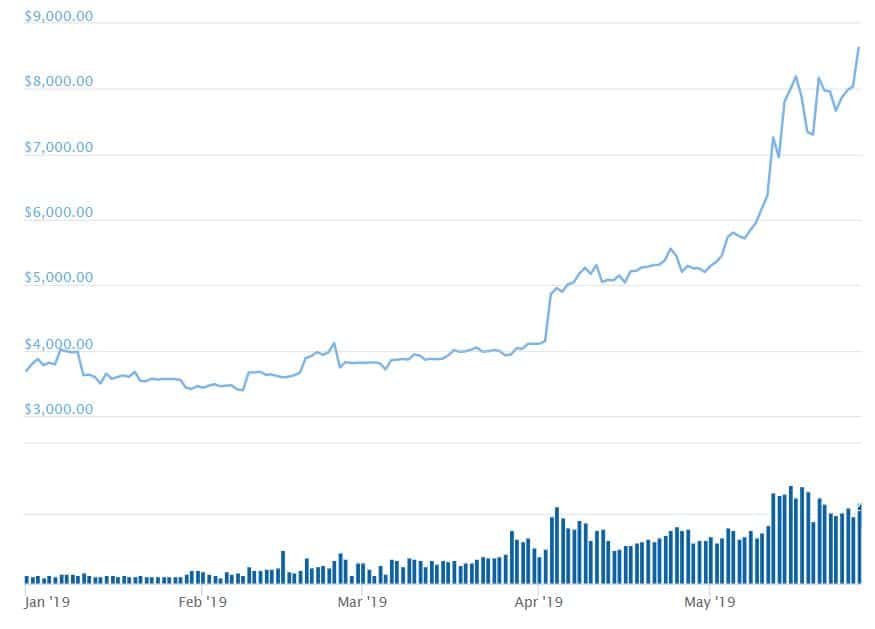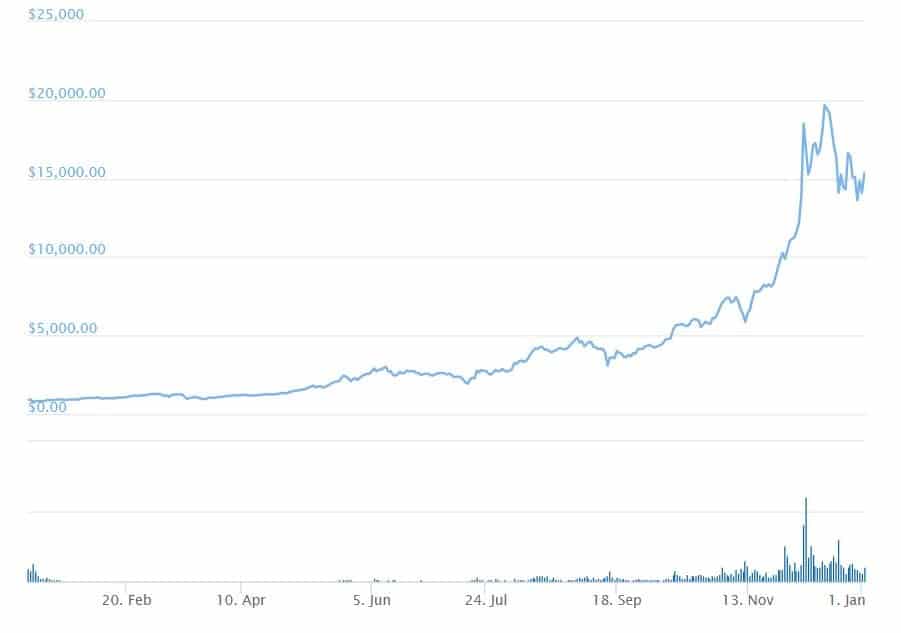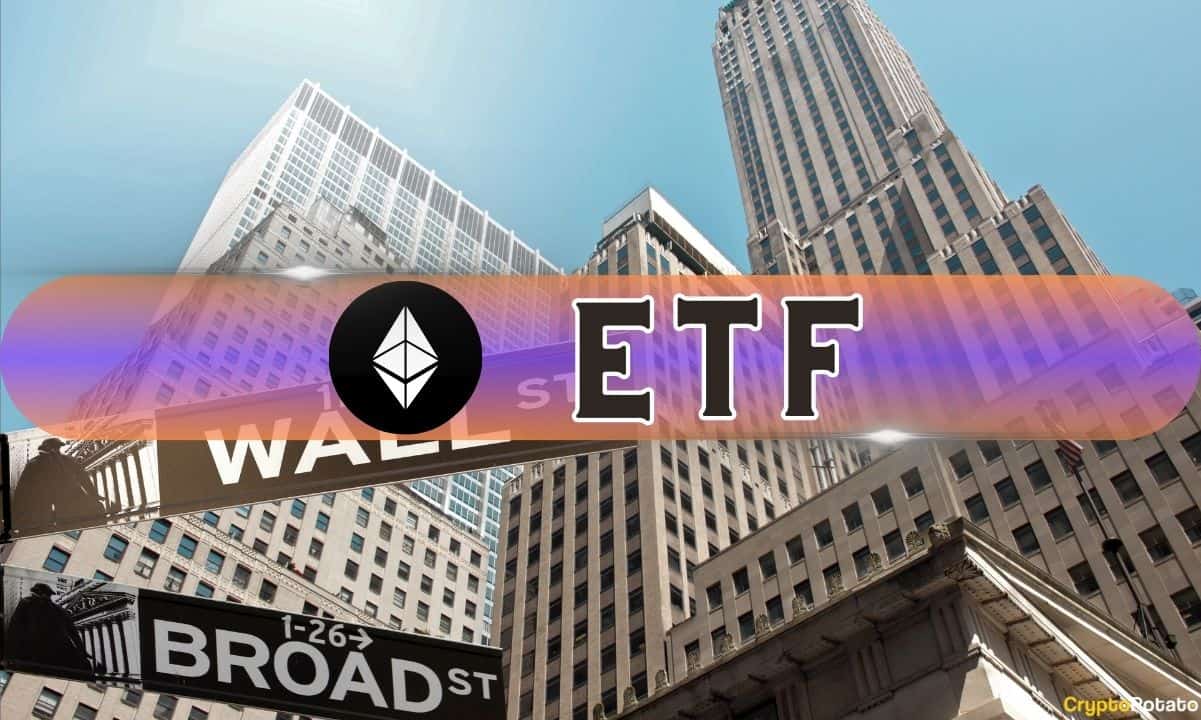Is Bitcoin Price Rising Too Quickly? Will It End Like 2017 Bull Market?
It’s safe to say that Bitcoin has had a stellar year so far in 2019. The price more than doubled, surging 137 percent year-to-date. With most of the gains made in the last two months, however, it’s perhaps reasonable to wonder whether or not things will end up as they did after the parabolic surge of late 2017.
Bitcoin Price on The Go in 2019
Following the prolonged bear market of 2018, this year has turned out to be a particularly good one for Bitcoin. The leading cryptocurrency in terms of market capitalization saw serious gains of about 137 percent since January 1st, 2019.

Most of these gains, however, were made in the last three months. The first notable leg up was at the beginning of April when Bitcoin spiked from around $4,100 to $5,100 in less than a few hours. The price continued to move upwards, breaching the important $6,000 resistance level without any notable difficulties. More importantly, it managed to remain above the level that was considered the ultimate support area of 2018, which was seen as a sign of additional strength (strong support became strong resistance).
The month of May saw remarkable gains for Bitcoin. By today, the price has increased by more than 64 percent in May alone, and we still have a few days left of it.
Yesterday, May 26th, saw another impressive leg up where Bitcoin spiked about 9 percent, reaching its current price of about $8,800, after touching almost $9000 on BitMEX exchange — raising questions if $9,000 is the next price target.
A Reminder of Bitcoin Price in 2017?
The current picture of the movement of Bitcoin’s price reminds quite a bit of what happened in late 2017 – the beginning of 2018. Back then, the year kicked off with Bitcoin trading at around $1,000, and by the end of May, it was sitting in the comfortable range of about $2,300. Interestingly enough, this represented an increase of around 130 percent – almost the exact number that we see in 2019 so far.

From there, the price started to move up only with minor corrections here and there. We all know how it ended: Bitcoin reached an astronomical value of about $20,000 towards the end of December, causing the entire world to turn its sights on it.
What followed, however, was more or less disturbing. 2018 was a year of a prolonged bear market where all the gains of the previous year were wiped off existence. Bitcoin plunged to yearly lows of around $3,100, which represented a decline of approximately 85 percent. The entire market suffered, as the market cap capitalization declined from over $800 billion to about $100 billion. This begs the question if history will repeat itself.
Looking closer, however, we can see that some incremental changes and differences may prevent this from happening.
What’s Different for Bitcoin in 2019?
First and foremost, we are a little less than a year from one of the most important upcoming events for the world’s leading cryptocurrency. The Bitcoin halving, as it’s referred to, is estimated to take place in May 2020.
Once it happens, the reward miners receive for adding blocks to Bitcoin’s network will be slashed in half, reducing the overall supply of Bitcoin. From 12.5 BTC per block that they get now, they will begin receiving 6.25 BTC. Basic economic principles suggest that if the demand for Bitcoin remains the same or it is higher, while the supply is reduced, the price should go higher. Moreover, it appears that the effect of Bitcoin halving starts to influence its price positively roughly around a year before it takes place.
Going further, we can also see institutional interest in the market that’s beginning to escalate. Fidelity, one of the leading investment companies, has already confirmed that they are in the final testing phase of their Bitcoin trading platform.
Bakkt, the much-awaited Bitcoin futures platform of the Intercontinental Exchange (ICE), has also announced that they will introduce user acceptance testing in July, revealing two types of BTC futures contracts.
Moreover, it appears that Bitcoin and other cryptocurrencies are seeing broader adoption now compared to 2017. As Cryptopotato reported earlier in May, mainstream giant AT&T has also begun accepting Bitcoin for bills through BitPay. This is just one of many examples.
Indeed, it does look like things are quite a bit different this time. It’s also important to note that, historically, following a bear market, Bitcoin has always managed to surge past its previous all-time high values. From the other side, any asset that produces violent parabolic moves to one side must see corrections along the way, this is the basic of trading, not limited to crypto trading only.
The post Is Bitcoin Price Rising Too Quickly? Will It End Like 2017 Bull Market? appeared first on CryptoPotato.









